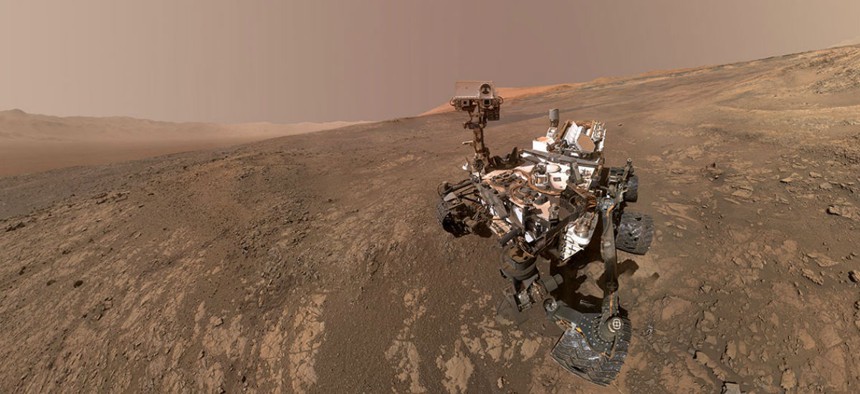Trump's Space Ambitions Are Too Big for One President

This self-portrait of NASA's Curiosity Mars rover shows the vehicle on Vera Rubin Ridge, which it's been investigating for the past several months. NASA
The reality of space travel squashed his impulsive desire to reach Mars in his first term, rather than the 2030s.
It is not the job of presidents to know the specifics of space exploration and its mind-bending physics, or to contemplate deeply the timescales and technology required for a high-stakes mission to another planet. But usually they have some sense of what’s remotely possible, and of what they’ve asked their space agency to do.
In the spring of 2017, President Trump signed a significant piece of legislation about the future of NASA. The bill, among other things, reaffirmed a top priority for the American space program: Sending humans to Mars by the 2030s.
Then, it seems, the president forgot all about it.
A month after signing the bill, Trump reportedly asked the then-acting administrator of NASA whether the space agency could send American astronauts to Mars by the end of his first term, and even offered him “all the money you could ever need” to make it happen. The NASA official politely turned him down, explaining that such a fast turnaround to a distant planet wasn’t possible.
The exchange, which took place in the Oval Office, appears in "Team of Vipers," a forthcoming book by former White House official Cliff Sims, and was first reported by New York magazine this week.
For anyone who knows about space travel, this encounter amounts to a breathtaking misunderstanding by a leader of the state of his nation’s space program. But it’s only the latest such mishap in Trump’s presidency. More than many presidents, Trump has been eager to talk about American ambitions in the cosmos. But his enthusiasm has clashed with his disinterest in the details of the complicated, risky requirements of actually sending people off this planet.
According to Sims, the discussion he describes took place at the White House in April of 2017, as Trump prepared to make a very long-distance video call from the Oval Office to the International Space Station. Peggy Whitson, a NASA astronaut, had broken the American record for the longest time spent in space, and the president was going to congratulate her.
About 10 minutes before the call, which was live-streamed to the public, Trump “suddenly turned toward” Robert Lightfoot, the acting administrator, and asked him: “What’s our plan for Mars?”
Lightfoot explained that NASA hopes to put people on the planet by the 2030s.
“But is there any way we could do it by the end of my first term?” Trump asked.
Sims writes that a fidgeting Lightfoot tried to explain some of the technical challenges of a Mars mission.
Trump was undeterred: “But what if I gave you all the money you could ever need to do it? What if we sent NASA's budget through the roof, but focused entirely on that instead of whatever else you’re doing now. Could it work then?”
Lightfoot said he was sorry, but no. The interaction, according to Sims, left the president “visibly disappointed.”
NASA directed my questions about this exchange to the White House. The White House did not respond to multiple requests for comment.
The call with the International Space Station began soon after. The question of Mars seemed to have stuck with Trump and, apparently unsatisfied with Lightfoot’s answer, the president decided to ask Whitson, the astronaut.
“What do you see a timing for actually sending humans to Mars? Is there a schedule? And when would you see that happening?” Trump said.
“Well, I think as your bill directed, it will be approximately in the 2030s,” Whitson replied.
“Well, we want to try and do it during my first term or, at worst, during my second term,” Trump said. “So we’ll have to speed that up a little bit, okay?”
“We’ll do our best,” she said, with a laugh.
At the time, the brief exchange came off as a mix of enthusiasm and confusion on Trump’s part. “Based on how he said it, it seemed like it was a tongue in cheek comment,” a White House spokesperson told me then. “I wouldn’t really look beyond that.” But according to Sims’s accounting, the president was apparently serious about getting to Mars during his presidency.
To echo Lightfoot, that’s not possible. The money would certainly be welcome, of course. What government agency would turn down presidential support for a budget influx? Especially NASA. During the Apollo era, the agency’s annual funding accounted for 4.5 percent of the federal budget. It shrunk to less than half a percent at the end of Richard Nixon’s terms, and has remained there since.
But cash is no substitute for time, and space travel is difficult to rush, even with Cold War tensions hovering menacingly in the background. Seven years elapsed between John F. Kennedy’s declaration to go to the moon and Neil Armstrong’s first steps on the lunar surface, and several Americans died in the effort to get there.
Timing beyond Earth matters, too. A Mars mission would ideally leave Earth when the two planets are close together in their orbits around the sun, a cosmic alignment that occurs every two years. The configuration would help shave off a few months on the journey to the red planet. Trump would have only two chances in the rest of his term, and in a potential second term, to deploy a crewed mission, 2020 and 2022. NASA isn’t ready for either.
The U.S. currently can’t launch its own astronauts from its own launchpads, and pays the Russian government tens of millions of dollars per seat on the Soyuz launch system to carry them to the International Space Station. NASA is working on a rocket designed to someday send astronauts to the moon and Mars, the Space Launch System, but a test flight, with people on board, won’t come until 2022.
Off the ground, the technical challenges of a Mars mission would be immense. Armstrong and Buzz Aldrin got along just fine in a cozy space capsule, but it took the astronauts just over three days to reach the moon. A trip to Mars would take as long as nine months, and astronauts would require a far more complex vessel. It would need to be hardy enough to protect them from cell-warping cosmic radiation, and roomy enough so people don’t get on each other’s nerves. This miraculous technology does not exist.
There’s an easy explanation for why Trump wants to send Americans to Mars during his presidency. It’s the same reason he enjoys speaking publicly about space exploration in general, and has actually done so more than other presidents, according to historians: people think space is cool. That includes congressional lawmakers, and space exploration enjoys some rare bipartisan support on Capitol Hill. For Trump, space policy is a safe topic. It’s an instant applause line. It gets good ratings, and to Trump, that’s what matters.
In February 2017, days after the inauguration, the White House made a surprising request to NASA. The administration asked the space agency to consider including a crew on the first flight of the Space Launch System. NASA had planned to put people on board only after a successful, uncrewed flight, a standard move for testing new rocket technology.
The Space Launch System, it turned out, had made it onto a list of moments that could bolster Trump’s legacy. “The common thread among many of the policy options, transition and industry officials said, is a focus on projects able to attract widespread voter support that realistically can be completed during Mr. Trump’s current four-year presidential term,” The Wall Street Journal reported at the time.
The attraction to visible, historic achievements has led Trump to confuse space policy more than once. In February 2018, Trump, like much of the public, was enamored with the spectacular launch of the Falcon Heavy, a massive rocket built by Elon Musk’s SpaceX. He praised the feat during a televised meeting at the White House with Cabinet leaders. He praised it so much, in fact, that he ended up undermining NASA's own rocket efforts.
“Rich guys, they love rocket ships,” the president said. “That’s good. That’s better than us paying for them. And I noticed the prices of the last one, that they said it cost $80 million. If the government did it, the same thing would have cost probably 40, 50 times that amount of money. I mean, literally, when I heard $80 million—you know, I’m so used to hearing different numbers with NASA.”
Indeed, he is; NASA has already spent several billion dollars on developing the Space Launch System. Each launch is expected to cost about $1 billion. Whether he meant to or not, Trump appeared to suggest that commercial companies would do a better and cheaper job of launching rockets than NASA. And he did it while a small replica of the Space Launch System sat on the table in front of him.
Despite Trump’s outsized interest in Mars, his administration’s space policy has taken a different direction since that spring meeting in 2017. In October of that year, the White House announced a dramatic shift in NASA's directive for the future. This was not a complete surprise; new presidents have tended to introduce fresh directives for NASA's future that diverge from those of their predecessors. George H. W. Bush proposed an ambitious plan that instructed NASA to simultaneously develop a space station above Earth, a mission to the moon, and a mission to Mars. Bill Clinton made no mention of sending Americans anywhere beyond Earth. George W. Bush instructed NASA to establish a program that would return Americans to the moon by 2020. Barack Obama canceled it, and told NASA to work on a Mars mission for the 2030s instead.
Under the Trump presidency, NASA would shoot for the moon, again. Mars would come eventually, but not before American astronauts stepped onto the lunar soil once more. NASA leaders spent eight years talking up a trip to Mars. Now, they’re touting a return to the moon. Jim Bridenstine, the NASA administrator, has said the agency seeks to land rovers on the surface of the moon as early as sometime this year, and “definitely” by 2020. As for a crewed mission, Bridenstine has said, “I don’t have a time frame for that at this point.”
If the Lightfoot encounter is any indication, that’s the kind of answer that Trump doesn’t like. But that is the reality of space exploration. They take years, sometimes decades, and delays are common. If technical difficulties don’t derail the schedule, politics will; programs supported by one president can get tossed out by the next. The actual, real work of building missions usually outlasts presidents. The commander-in-chief who will lead the nation to humankind’s first steps on Mars is not in the White House, and may not be for years to come.



